by Lisa Cooke | May 13, 2017 | 01 What's New, FamilySearch, Research Skills |
I have thoroughly enjoyed having Amie Tennant as a blogger for the past year. In her final blog post for Genealogy Gems she takes us on a tour of her home state’s digital records. Then she will be turning all of her attentions to her own genealogical certification. Thank you Amie for all of your helpful and thoroughly enjoyable posts! – Lisa Louise Cooke
Ohio genealogy research goes digital. You can now virtually walk into any courthouse in Ohio with the click of the mouse. Check out the amazing browse-only databases at FamilySearch for Ohio and other states, and take your family history research to the next level.
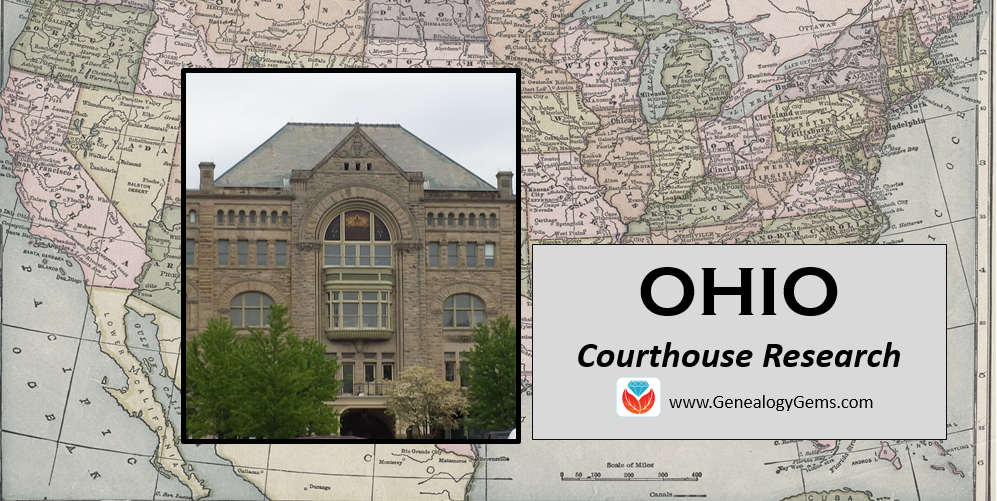
I use FamilySearch.org to search courthouse record books all the time. In particular, the Ohio Probate Records, 1789-1996 now have nearly 7 million digital images of county record books such as wills, estate files, guardianship records, naturalization records, minutes, bonds, and settlements. In fact, many other states have their court record books online at FamilySearch, too. So, why haven’t you noticed before?
Browse-only Databases vs. Indexed Databases
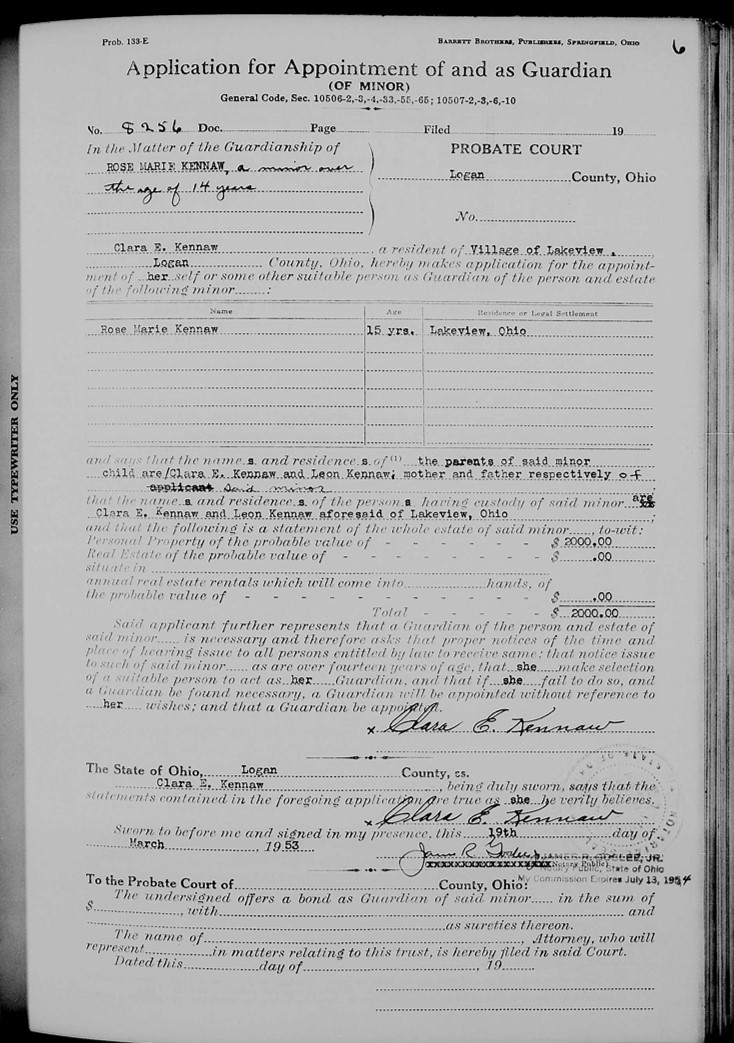 You may have read our previous post on step-by-step instructions to using browse-only databases at FamilySearch. If you didn’t, you should know that when you are searching for records at FamilySearch using the traditional search fields, you are only searching for records that have been indexed. In other words, there may be thousands of records you need on the site, but you won’t find them. They have not been indexed by a searchable name, place, or date. Instead, you need to go in the virtual “back door.”
You may have read our previous post on step-by-step instructions to using browse-only databases at FamilySearch. If you didn’t, you should know that when you are searching for records at FamilySearch using the traditional search fields, you are only searching for records that have been indexed. In other words, there may be thousands of records you need on the site, but you won’t find them. They have not been indexed by a searchable name, place, or date. Instead, you need to go in the virtual “back door.”
Step 1: First, go to FamilySearch and sign in. Next, click Search at the top right. Now you will see a map of the world. Click on the desired location. I have chosen the U.S., but you can choose any country you are interested in.
Step 2: Once you choose your desired country or continent, a pop-up list will be available and allow you to choose the state (or country) you wish to search in. In this case, a list of the U.S. states appears and I clicked on Ohio.

Step 3: The system will direct you to a new page. You will first see the Ohio Indexed Historical Records. These are the records and collections that have been indexed and are searchable by name, date, and place. Though these are great, they are not the record collections I want to share with you today.
Instead, scroll down until you see the heading Ohio Image Only Historical Records. You will notice several databases such as cemetery records, church records, naturalization records, etc. All of these are browseable. That means you will use them like you would microfilm.
Step 4: I want to bring your attention to a specific record collection, so scroll down even further until you see Ohio Probate Records, 1789-1996. Click it.
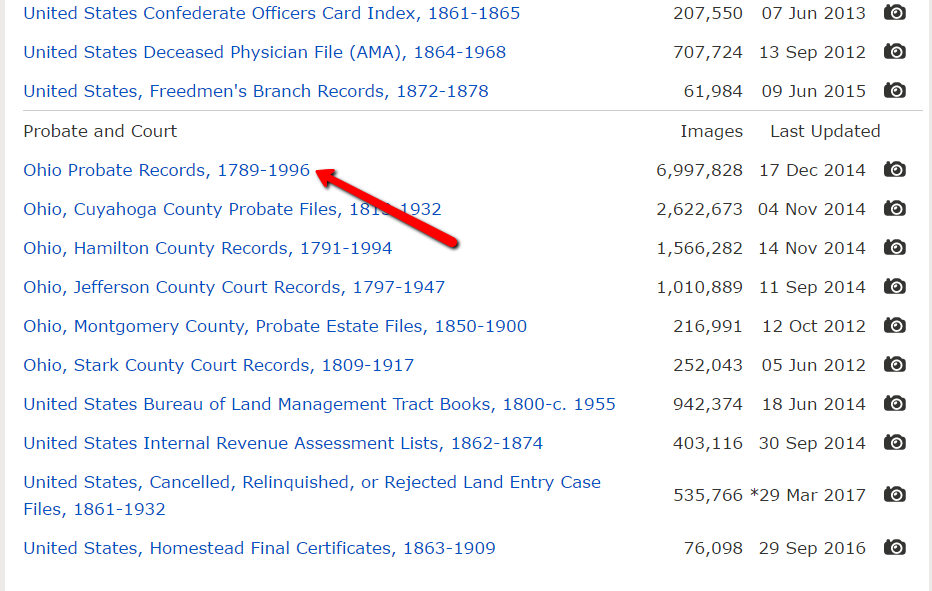
At the next screen, you will see you can browse the 6,997,828 Ohio probate records and you are probably thinking, “What!? I can’t possibly browse through nearly 7 million records!” But, you can, so go ahead and click it!
Step 5: At the new screen, you will see everything is broken up into counties. Click on the county you are interested in researching. You will next see a list of possible record books available for that county. Each county will vary, so where you may find guardianship records available in one county, you might not find them in another.
Ohio Genealogy Research at the Courthouse
As a refresher, courthouse research is often imperative to thorough genealogy research. Here is a helpful chart of the type of information you may find in these types of court records. Be sure to remember: records and the amount of information they contain change over time.
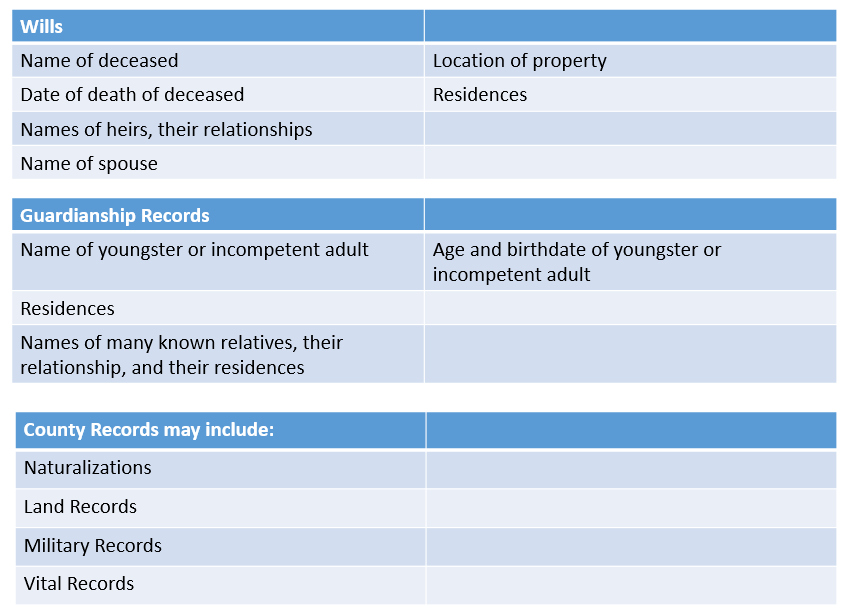
More on Courthouse Research Techniques
Are you looking to understand the value of courthouse research and how to use those records to overcome brick walls in your family tree? Read 4 Ways to Power Up Your Courthouse Research Skills from our own Sunny Morton.
by Lisa Cooke | Oct 19, 2016 | 01 What's New, Court Records, Inspiration |
Researching court records may require some advanced genealogical skills, but the benefits are worth the effort. Lisa Louise Cooke helps a reader get out of a genealogical slump and makes the case for why you should be researching court records.

Our reader shared:
I have been doing my family tree on and off for about 10 years. Right now, I feel I’m in a slump. A couple of years ago, I started the NGS Home Study Course. I have only got up to lesson six. I feel obligated to finish all 16 lessons. I get motivated to do genealogy when I read various articles on it. However, I can’t get motivated to do the work. This has bothered me for a year. Do you have any suggestions on how to get back on track? I know court records seems like a big mountain for me. Thank you in advance for any suggestions.
We all definitely hit slumps. I have some ideas and some motivations for you, because you are not alone.
Getting Over the Slump
You mentioned that you “feel obligated.” In reading your email, I’m curious as to what your original motivation was to do the course. If it was to become a professional genealogist, my answer would be different than if this was for your personal improvement. If this was for your own personal improvement, then you have much more flexibility.
At one time, the NGS American Home Study Course gave you a very lengthy time to finish the course work. Now, the classes are offered virtually online. Because of this change, the Home Study Courses are currently divided into four segments. Within each of these segments, you have four classes, or assignments. You are given six months to complete these four classes within your specific segment. For those who need extra time, a one-time extension of three months is granted by contacting the NGS Course Administrator. Also with this change, you may feel a little more pressure to finish quickly.
Genealogy Gems Contributor Amie Tennant offers this advice:
“First of all…when I took the NGS Home Study Course, I got in a huge slump too! It took nearly 3 years for me to finally finish all the course work. One thing that helped (which helps me now with getting behind in my certification portfolio,) is a method I call “A record a day, keeps procrastination at bay.” When I get bored or unmotivated, it is usually because something has gotten difficult. Lessons 1-6 of the NGS class were really easy for me, but after that it got harder, especially when it was time to do the courthouse review exercise that encourages you to make a visit. Even if you can’t visit the courthouse, you can often find appropriate records online. By promising myself a smaller more attainable goal like finding one key record a day online, I could keep motivated. Eventually something clicks and you get that excitement again.
Lastly, when I was really struggling, I took a friend. We made a day of it with researching at the courthouse and then having a nice relaxing lunch. It was a great day!”
Like Amie, when I find myself unmotivated, it is usually because it’s not my burning interest at that time. If I’m doing genealogy for personal use, I don’t fight it. Life’s too short and genealogy should be fun and invigorating. Sometimes, we’re just not ready for a particular record type, and if it’s not bringing your research to a standstill, there isn’t as much motivation. For me, there’s nothing like revisiting the excitement of what is waiting to be found! I asked Genealogy Gems followers on Facebook to share the Court gems they have found, and I hope it fills you with renewed excitement and enthusiasm. But first, here are some ideas on how to research court records:
Researching Court Records – How to
To get the most from researching

Will records are always a great find when researching court records.
court records, here are four tips to keep in mind:
1. Call the courthouse first. Ask them when they are open, days and times, and if they close during the lunch hour. (Sometimes this information on their website is not up to date.)
2. Ask what records are available at that location and for what years. It would be awful to drive to a far off location, only to find the probate records you are interested in are now housed 5o miles away at another repository!
3. Take the following with you: paper, pencils, a camera or smartphone, small bills and coins, a bottle of water and small snack. Even though there may be rules preventing you from snapping a picture of the document you want, you never know. The money comes in handy if you have to pay for copies of the records you want. Also, you are likely going to be there for awhile, so having a little snack will keep you from thinking only about your empty stomach.
4. Make your visit to the courthouse when you are not in a hurry. Let your finds determine how long you stay. When you are pressed for time, you may inadvertently skip over an important find, so set the whole day aside.
Making the Case for Court Records – Inspiration!
I asked our readers “What Genealogy Gems have you found in court records?” Get ready to soak in their excitement!
Kathleen shared: “An ancestor in the 1840s was living in Mississippi and had a 2nd wife and children. Everyone always assumed that the 1st wife died. Nothing in any records ever indicated anything different. On a trip to Salt Lake City ten years ago, I was frustrated and hitting dead ends. I decided to pull a film for Lawrence County, Mississippi loose court papers. It was NOT indexed and I was just browsing out of curiosity. I found my ancestor in 1849 with eleven pages of hand written divorce papers! She accused him of mistreatment and moving a slave woman into their residence who had threatened her with a knife when she went to get money for her nine children!”
Brian shared: “My brick wall has been my 2nd great-grandfather, John B. Reese. I knew he died sometime before 19 Dec 1856, as that was the date his estate entered probate. On a recent research trip to Missouri, I visited the Bates County Historical Museum where Chris Wimsatt found an entry in the County Stray Book indicating that John B. had found a stray “strawberry rone [roan] 3 years old 14 hands 3 inches high” 24 May 1856. Woo hoo! Narrowed that death date right down!”
Helen shared: “Just solved a century old mystery in the basement of a courthouse in the insane books. What would now be called postpartum psychosis.”
Diane: “My mom had a wealthy Aunt Jenny; we have her silver, antiques, etc. She was married to a lawyer who became Chief Justice of the Rhode Island Supreme Court in the 1890s-1900s. I knew she was from a poor family and couldn’t imagine how they met. I found a hidden first marriage for her that my mom never knew about. When I got the divorce papers, turns out husband #2 had BEEN HER HUSBAND’S LAWYER. My mom almost fell over when I called her on the way home.”
Maria: “I also found a great uncle who ended up marrying a widow who was a millionaire from her late husband – she was old enough to be his mother & had step children older than him! Her life was in newspapers and court records! I found someone local to scan her succession & her late husband’s succession court documents to me. Fascinating stuff from the turn of the century to the 1930’s! It’s all public records! Also tracked down her great grandson; he sent me priceless photos. The kicker is after I found where the late husband was buried to document on Ancestry, the cemetery actually mailed ME a bill for grass cutting! – twice!”
Pat: “My great uncle came from Germany to wild West Denver 1860 and became a hard rock miner. How did I know? His court records regarding his death “found frozen to the floor in his mining cabin” shows what he owed at the time of death. Actual grocery list from Hancock Bros. Dry Goods Store where he bought (among other things) blasting powder, helped ID that he was hard rock rather than placer miner. Funeral info about how much it cost to dig his grave, use of team of horses, and a new set of clothes… Amazing. Find a Grave volunteer found the spot where he was buried WAY off the grid, off a side road. No headstone. Depression in grass x many feet from old fence. Volunteer contacted local historical society for me to find this on his own. Incredible. I wrote his story.”
More Gems on Researching Court Records
It seems many of us have had exciting breakthroughs researching court records. If you have had a triumph and would like to share, please let us know in the comments below. You can also read about even more inspiring ways to take your courthouse research to the next level in these articles below. Happy hunting!
4 Ways to Power Up Your Courthouse Research Skillls
Where to Look When There’s Been a Significant Record Loss
by Lisa Cooke | Dec 18, 2015 | 01 What's New, Records & databases
Here’s our weekly roundup of new genealogy records online that caught our eye. This week there are a lot of US records: Alabama Episcopal church registers, Connecticut sourt records, Kansas probate records and New York Evening Post death notices. Immigration records for Brazil and Italian civil registrations are also on the list!

ALABAMA CHURCH. The Birmingham Public Library’s index to Alabama Episcopal Church registers (1832-1972) is now also searchable on Ancestry as a Web Index (click here to learn about Ancestry Web Indexes). The index includes “confirmations, baptisms, marriages and burials for more than 14,000 people in sixteen Alabama parishes for the period of the 1830s to the 1970s.”
(click here to learn about Ancestry Web Indexes). The index includes “confirmations, baptisms, marriages and burials for more than 14,000 people in sixteen Alabama parishes for the period of the 1830s to the 1970s.”
BRAZIL IMMIGRATION. Over 2.2 million indexed records have been added to a free FamilySearch collection of Brazil Rio de Janeiro Immigration Cards (1900-1965). These records, in Portuguese, “contains immigration cards issued by Brazilian buy tapeworm medication dogs consulates around the world. These cards were then presented at the port of entry by foreigners visiting or immigrating to Brazil through the port of Rio de Janeiro from 1900-1965.”
CONNECTICUT COURT. Over a quarter million indexed records have been added to FamilySearch’s free index to Connecticut District Court naturalizations (1851-1992)
ITALY CIVIL REGISTRATION. Nearly a quarter million indexed records have been added to FamilySearch’s free collection of Italian civil registrations for Taranto, 1809-1926.
KANSAS PROBATE. Ancestry’s collection of Kansas wills and probate records has been freshly updated. Kansas wills and probate records The current database covers nearly two centuries (1803-1987) and covers at least some time periods in nearly half of Kansas’ 105 counties.
The current database covers nearly two centuries (1803-1987) and covers at least some time periods in nearly half of Kansas’ 105 counties.
NEW YORK DEATHS. An index to over 100,000 death notices from the New York Evening Post (1801-1890) is now available to subscribers at AmericanAncestors.org. “Page images and an index searchable by first and last name, location, and year are included.”
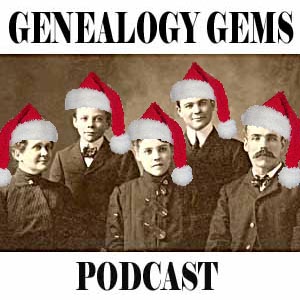 Merry Christmas and Happy New Year!
Merry Christmas and Happy New Year!
Disclosure: This article contains affiliate links and Genealogy Gems will be compensated if you make a purchase after clicking on these links (at no additional cost to you). Thank you for supporting Genealogy Gems!

 You may have read our previous post on step-by-step instructions to using browse-only databases at FamilySearch. If you didn’t, you should know that when you are searching for records at FamilySearch using the traditional search fields, you are only searching for records that have been indexed. In other words, there may be thousands of records you need on the site, but you won’t find them. They have not been indexed by a searchable name, place, or date. Instead, you need to go in the virtual “back door.”
You may have read our previous post on step-by-step instructions to using browse-only databases at FamilySearch. If you didn’t, you should know that when you are searching for records at FamilySearch using the traditional search fields, you are only searching for records that have been indexed. In other words, there may be thousands of records you need on the site, but you won’t find them. They have not been indexed by a searchable name, place, or date. Instead, you need to go in the virtual “back door.”







 Merry Christmas and Happy New Year!
Merry Christmas and Happy New Year!


